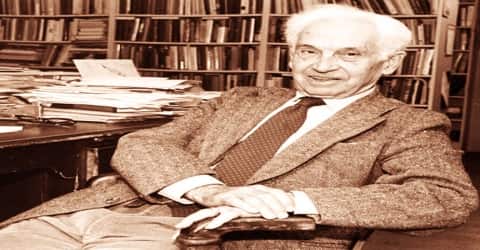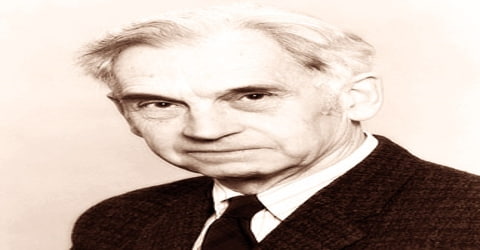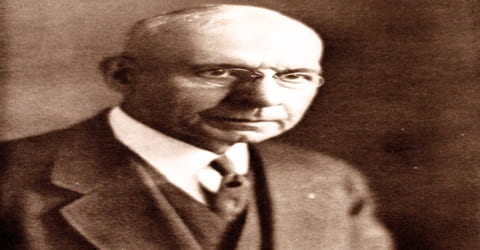Biography of Ernst Mayr
Ernst Mayr – German-American biologists.
Name: Ernst Walter Mayr
Date of Birth: July 5, 1904
Place of Birth: Kempten, Bavaria, Germany
Date of Death: February 3, 2005 (aged 100)
Place of Death: Bedford, Massachusetts, United States
Occupation: Biologists
Father: Dr. Otto Mayr
Mother: Helene Pusinelli
Spouse/Ex: Margarete Simon
Early Life

A German-born American biologist known for his work in avian taxonomy, population genetics, and evolution, Ernst Mayr was born in Kempten, Germany on July 5, 1904, to Dr. Otto Mayr and Helen Pusinelli. He was one of the 20th century’s leading evolutionary biologists. He was also a renowned taxonomist, tropical explorer, ornithologist, philosopher of biology, and historian of science. His work contributed to the conceptual revolution that led to the modern evolutionary synthesis of Mendelian genetics, systematics, and Darwinian evolution, and to the development of the biological species concept.
His work on the theory of evolution paved way for the modernized concepts in genetics and evolutionary biology which includes the works of Mendel, Darwin, and the concepts of ‘systematics’ and ‘biological species’. Mayr has been credited with writing more than 100 papers on avian taxonomy. He proposed a new definition of species that was widely accepted in scientific circles and contributed to the discovery of a large number of previously unknown species. Mayr successfully discovered and named 25 new bird species and 410 sub-species, during his lifetime. Through his book ‘Systematics and the Origin of Species’, he put forward a modification to the existing definition of species. A group of individuals with similar morphological traits was regarded as members of the same species (as stated by Charles Darwin) but Mayr suggested that members of a group that interbreeds comprise a species. The information contained within the DNA of each species differs enough from other species to prevent interbreeding. In his later years, Mayr focused his efforts in modifying the philosophy of science to include biology as an essential way of understanding life.
His theory of peripatric speciation (a more precise form of allopatric speciation which he advanced), based on his work on birds, is still considered a leading mode of speciation and was the theoretical underpinning for the theory of punctuated equilibrium, proposed by Niles Eldredge and Stephen Jay Gould. Mayr is sometimes credited with inventing modern philosophy of biology, particularly the part related to evolutionary biology, which he distinguished from physics due to its introduction of (natural) history into science.
Childhood, Family and Educational Life

Ernst Mayr, in full Ernst Walter Mayr, was born on July 5, 1904, in Kempten, Germany, to parents Dr. Otto Mayr and Helen Pusinelli. Dr. Otto Mayr, by profession, was a law practitioner but he was a keen-naturalist and took his kids on visits to inculcate in them a love and understanding of their natural surroundings. His father died just before he was thirteen. The family then moved to Dresden and he studied at the Staatsgymnasium (“Royal Gymnasium” until 1918) in Dresden-Neustadt and completed his high school education there.
In April 1922, while still in high school, Mayr joined the newly founded Saxony Ornithologists’ Association. Here he met Rudolf Zimmermann, who became his ornithological mentor. In February 1923, Mayr passed his high school examination (Abitur) and his mother rewarded him with a pair of binoculars. Mayr attended the University of Greifswald in 1923, initially studying medicine. He studied birds around the university countryside and he exchanged correspondence with a school friend, Erwin Stresemann who was already a leading ornithologist.
In 1925 Stresemann encouraged Mayr to switch his studies to biology and to develop his passion for ornithology into a career. Mayr acquired his doctorate in ornithology from the University of Berlin in 1926; he was only 21 years old. Mayer then accepted a position at the Berlin Museum.
Personal Life
In 1931, Ernst Mayr moved from Germany to the United States, to join the American Museum of Natural History; while he was in America, the Nazis took over Germany. Ernst, who was grateful to be safe in New York, settled permanently in the United States.
In 1935, Ernst Mayr married Margarete Simon. They had two daughters and their marriage lasted more than 55 years until his wife passed away.
Mayr said he was an atheist in regards to “the idea of a personal God” because “there is nothing that supports it”
Career and Works

At the International Zoological Congress at Budapest in 1927, Ernst Mayr was introduced by Stresemann to banker and naturalist Walter Rothschild, who asked him to undertake an expedition to New Guinea on behalf of himself and the American Museum of Natural History in New York. In New Guinea, Mayr collected several thousand bird skins (he named 26 new bird species during his lifetime) and, in the process also named 38 new orchid species. During his stay in New Guinea, he was invited to accompany the Whitney South Seas Expedition to the Solomon Islands. Also, while in New Guinea, he visited the Lutheran missionaries, Otto Thiele and Christian Keyser, in the Finschhafen district; there, while in conversation with his hosts, he uncovered the discrepancies in Hermann Detzner’s popular book Four Years Among the Cannibals in German Guinea from 1914 to the Truce, in which Detzner claimed to have seen the interior, discovered several species of flora and fauna, while remaining only steps ahead of the Australian patrols sent to capture him.
The year 1930 marked the end of the expedition upon which he was appointed a curator of ‘American Museum of Natural History’. It was here that he penned some of his most comprehensive compilations on the taxonomy of birds. These finding gave Mayr thought for his evolutionary theory which he would publish later in 1942.
Mayr continued his studies as the curator of the ornithological department at the American Museum of Natural History in New York (1932-53), where he wrote more than 100 papers on avian taxonomy, including ‘Birds of the Southwest Pacific’ (1945). He proposed in 1940 a definition of species that won wide acceptance in scientific circles and led to the discovery of a number of previously unknown species; by the time of his death, he had named some 25 new bird species and 410 subspecies.
Mayr published his famous book “Systematics and the Origin of Species” in 1942, which heavily contributed to population genetics and the evolutionary synthesis theory. The evolutionary synthesis relies on a combination of gene mutations, variation (recombination), heredity, natural selection and isolation to generate new species. Ernst Mayr approached the concept of species by saying that a species is not merely a group of morphologically closer individuals, but a group that breeds only amongst themselves, excluding all others. The theory of peripatric speciation by Mayr is considered a major mode of speciation in ornithology.

In 1953 Mayr became Alexander Agassiz Professor of Zoology at Harvard University, and from 1961 to 1970 he served as director of the university’s Museum of Comparative Zoology. He became professor emeritus at Harvard in 1975. He retired in 1975 as emeritus professor of zoology, showered with honors. Following his retirement, he went on to publish more than 200 articles, in a variety of journals more than some reputable scientists publish in their entire careers; 14 of his 25 books were published after he was 65. Even as a centenarian, he continued to write books. On his 100th birthday, he was interviewed by Scientific American magazine. Mayr’s works include Methods and Principles of Systemic Zoology (with E.G. Linsley and R.L. Usinger; 1953), Animal Species and Evolution (1963), The Growth of Biological Thought (1982), and What Evolution Is (2001).
Awards and Honor
In 1939 Ernst Mayr was elected a Corresponding Member of the Royal Australasian Ornithologists Union. He was awarded the 1946 Leidy Award from the Academy of Natural Sciences of Philadelphia.
Ernst Mayr received the ‘Darwin-Wallace Medal’ in 1958 because of his work on the definition of species and his contribution in advancing Darwin and Mendel’s theories on evolution.
For his work, Animal Species and Evolution, Mayr was awarded the Daniel Giraud Elliot Medal from the National Academy of Sciences in 1967. In 1969, the President of the United States awarded this scientist extraordinaire the prestigious ‘National Medal of Science for Biological Studies’, for his contribution to the field of biology. Mayr was elected a Foreign Member of the Royal Society (ForMemRS) in 1988.
Mayr received the ‘International Prize for Biology’ in 1994 for his work in advancing research on fundamental biology. In 1995 he received the Benjamin Franklin Medal for Distinguished Achievement in the Sciences of the American Philosophical Society.
Death and Legacy
Ernst Mayr died on 3 February 2005 in his retirement home in Bedford, Massachusetts after a short illness. He was diagnosed with cancer a few weeks prior to his last days. His wife, Margarete, died in 1990. He was survived by two daughters, five grandchildren, and 10 great-grandchildren.
Ernst Mayr presented his ideas on evolution and species in his most significant book ‘Systematics and the Origin of Species’ in 1942. His theory was integration and progression on the works of Gregor Mendel (genetics) and Charles Darwin (natural selection). In his lifetime, Mayr named around 25 new bird species, 410 sub-species, and over 38 new orchid species in New Guinea itself.
Mayr was an outspoken defender of the scientific method, and one known to sharply critique science on the edge. As a notable example, in 1995, he criticized the Search for Extra-Terrestrial Intelligence (SETI) as conducted by fellow Harvard professor Paul Horowitz as being a waste of university and student resources, for its inability to address and answer a scientific question. Over 60 eminent scientists led by Carl Sagan rebutted the criticism.
Harvard University established the ‘Ernst Mayr Library of the Museum of Comparative Zoology’, in the honor of this erudite biologist.
Information Source:
















